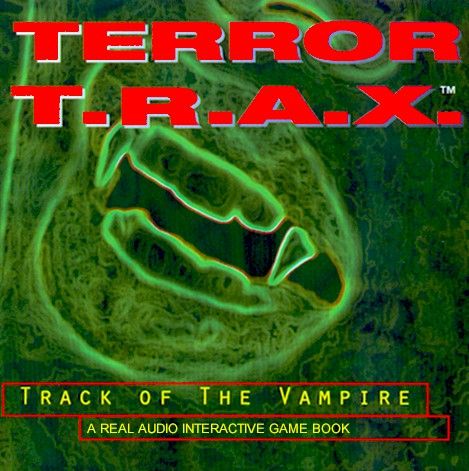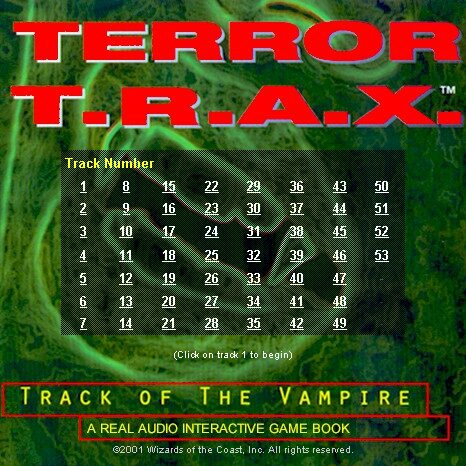Retro Replay Review
Gameplay
Terror T.R.A.X.: Track of the Vampire presents a refreshingly unique interactive experience by placing you in the role of a dispatcher‐supervisor at a paranormal response agency. Unlike conventional point‐and‐click adventures, the game’s core mechanic revolves around listening to distress calls and using the T.R.A.X. (Trace, Research, Analyze, and eXterminate) computer system to direct agents in the field. Each call unfolds as an audio track on the CD, and you must decide which of two options best serves your agents’ safety—steering you to the appropriate track number for the next segment of the drama.
(HEY YOU!! We hope you enjoy! We try not to run ads. So basically, this is a very expensive hobby running this site. Please consider joining us for updates, forums, and more. Network w/ us to make some cash or friends while retro gaming, and you can win some free retro games for posting. Okay, carry on 👍)
The decision points in Terror T.R.A.X. are deceptively simple but carry real weight. A single wrong choice can lead to an agent’s demise or an escalating supernatural threat, fostering a tense atmosphere akin to live radio theater. With every ring of the line, you’ll weigh medical emergencies against hostile vampires, puzzle out cryptic clues, and manage limited resources in real time. This makes each playthrough feel like a high‐stakes mission in an X‐Files–inspired world.
Replayability is a standout feature. Because the CD holds multiple branching tracks for each call, you can revisit scenarios to explore alternative outcomes or uncover hidden narrative threads. While the game’s interface can feel rudimentary by modern standards—requiring manual track selection on an actual CD or precise click navigation in the browser version—this tactile engagement heightens immersion, making you feel like a true dispatcher working under pressure.
Of course, the reliance on audio tracks and track listings introduces a learning curve. New players may find the initial setup and track‐jumping mechanics awkward, particularly in the browser version, which depends on Realplayer or Real Jukebox plugins. However, once you acclimate to these vintage controls, the spooky, reactive storytelling keeps you glued to your seat, eagerly anticipating the next call for help.
Graphics
As an audio drama first and foremost, Terror T.R.A.X. foregoes dynamic 3D visuals in favor of evocative soundscapes supplemented by minimalist static imagery. The original 1994 CD release came with atmospheric cover art and printed track listings, but the in‐game “graphics” consist largely of simple menus and text prompts. This design choice directs your full attention to the eerie voice performances and ambient effects—lighting your imagination to fill in the details.
When Wizards of the Coast reissued the game seven years later with a browser interface, they retained this stripped‐down aesthetic. The interface features a grid of call icons, basic buttons for your two response options, and a static map of your agents’ locations. It’s clean and serviceable, emphasizing function over flair. For players seeking slick animations or dynamic environments, the lack of modern graphical polish may feel jarring, but it perfectly complements the game’s roots as an audio drama.
Audio quality effectively becomes your “visuals.” Crackles of static, distant screams, and faint echoes of wings create a vivid mental picture of shadowy crypts and blood‐soaked alleyways. In a strange way, the absence of rendered graphics heightens tension. You’re not watching pixelated vampires; you’re listening for the faintest heartbeat behind the chatter of your dispatcher console.
While you won’t find texture filtering or high‐resolution sprites here, the period‐accurate CD artwork and the rudimentary browser interface possess a retro charm. If you view this title as a living radio play rather than a graphically intensive video game, the minimal visuals become a strength, focusing your senses on the unsettling audio drama that defines the experience.
Story
The premise of Terror T.R.A.X. reads like a classic X-Files episode: you’re the central hub in a clandestine agency fielding 911 calls that verge on the supernatural. Each dispatched call brings you face‐to‐face with vampire lore—ranging from solitary creatures of the night to full‐blown blood cult gatherings. As dispatcher, you sift through chattering callers, interpret ambiguous descriptions, and direct field agents into life‐or‐death confrontations.
The writing strikes a fine balance between pulpy horror and procedural authenticity. Callers range from panicked civilians to self‐aware vampire hunters, and their diverse personalities add richness to the narrative. T.R.A.X. herself, voiced by a calm but authoritative female A.I., offers dry commentary and technical cross‐checks, reminding you that every choice carries procedural consequences. This interplay of character voices deepens the world outside your direct control.
Branching narratives shine when you opt for aggressive strikes versus cautious retreats. One decision might lead an agent into an ambush, while another could unearth a hidden backstory about a centuries‐old vampire patriarch. These divergent threads reward multiple replays, and discovering new audio segments feels akin to unlocking secret levels in a more graphic‐intensive game.
Although the story is self‐contained within its four‐part CD framework, it leaves tantalizing hints of a broader universe populated by supernatural threats beyond vampires. The hints at other paranormal emergencies set the stage for the full four-episode arc, inviting players to seek out the remaining discs if they crave a deeper dive into TSR’s imaginative horror anthology.
Overall Experience
Terror T.R.A.X.: Track of the Vampire stands out as a bold experiment in interactive audio storytelling. Its emphasis on suspenseful radio‐drama presentation, paired with meaningful branching choices, results in an experience unlike typical point-and-click adventures. For players who relish atmospheric horror and don’t mind a bit of manual track selection or plugin setup, this is a rare gem that delivers genuine chills.
However, the game’s vintage format does present accessibility challenges. Modern systems may balk at RMJ files or Realplayer dependencies, and the charm of manually flipping CD tracks can wear thin for those accustomed to seamless digital interfaces. Patience and a willingness to embrace 1990s technology are rewarded with a unique sense of immersion—as if you’ve stepped into a midnight radio station broadcasting from a haunted headquarters.
Replay value is noteworthy, thanks to the multiplicity of call outcomes and hidden tracks. Horror enthusiasts will find themselves revisiting scenarios to tease out every possible fate, while collectors of retro gaming will appreciate the historical significance of TSR’s early multimedia foray. The blend of choice‐driven gameplay with pure audio drama ensures that each session feels fresh and suspenseful.
In summary, Terror T.R.A.X.: Track of the Vampire offers a singular blend of horror narrative and interactive decision-making. It’s ideally suited for players who enjoy immersive audio experiences, enjoy tinkering with legacy formats, and appreciate the thrill of guiding agents through a web of vampiric mysteries. Approach it with an open mind and a headphone set, and you’ll discover a chilling adventure that still echoes through the corridors of retro gaming history.
 Retro Replay Retro Replay gaming reviews, news, emulation, geek stuff and more!
Retro Replay Retro Replay gaming reviews, news, emulation, geek stuff and more!





Reviews
There are no reviews yet.